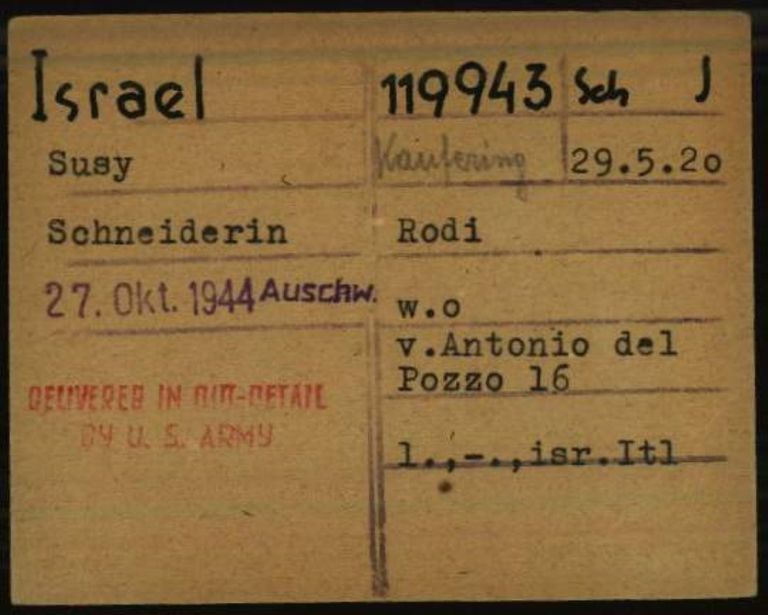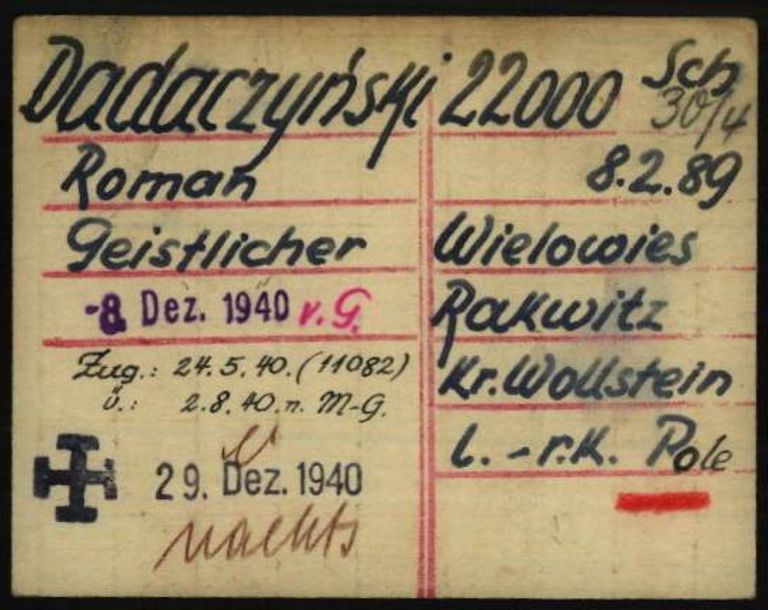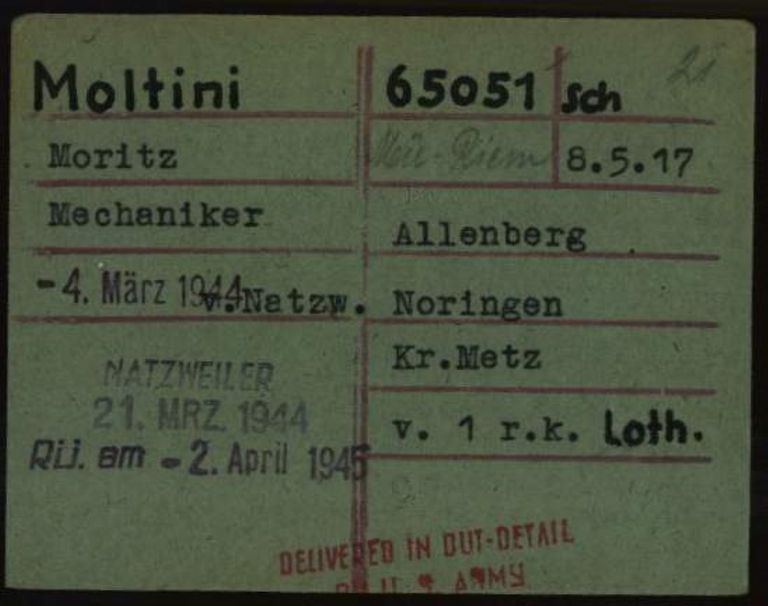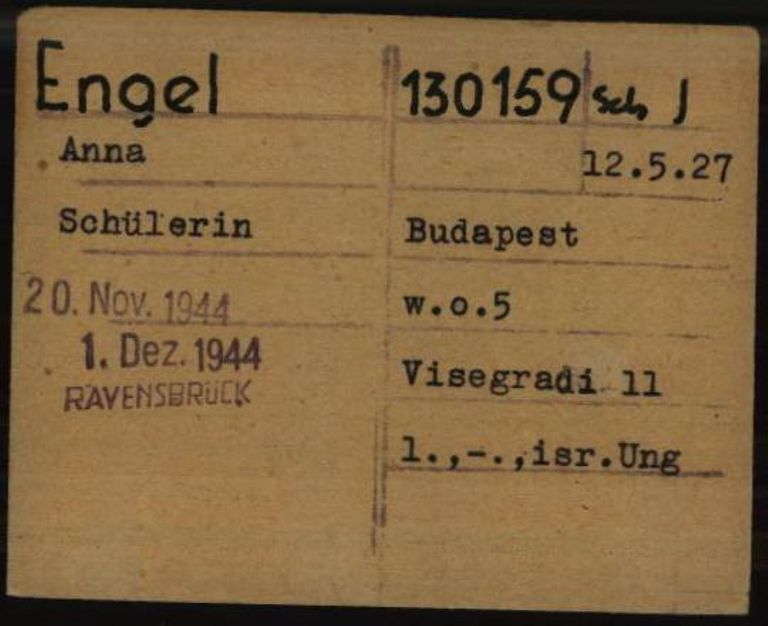Page of
Page/
- Reference
- Intro
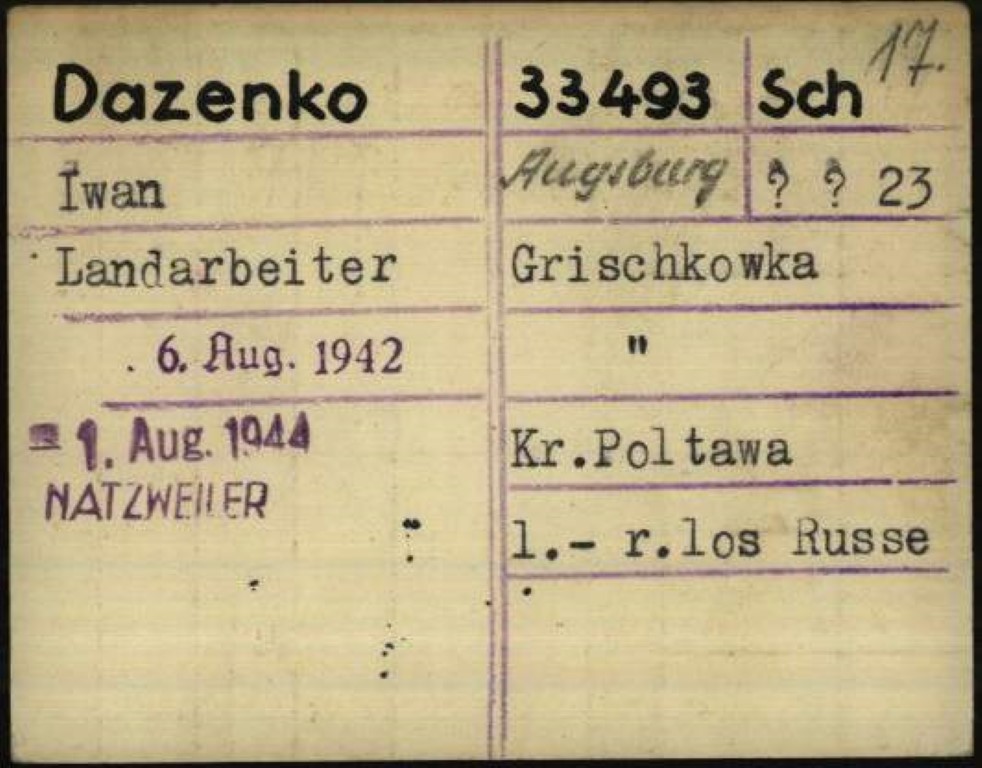

This card is from the registry office card file of Dachau concentration camp. Prisoner clerks in Dachau stamped a grid on these cards and entered the prisoners’ personal details in the fields following a specific template. Registry office cards from Dachau come in different colors because the clerks always used whatever paper was currently available. The cards were either filled out by hand or on a typewriter. They differ primarily in the information in the lower left section, which can be either very brief – with only a date and the camp to which the prisoner was transferred – or very detailed. For example, information on escape attempts is noted in this area on some of the cards.
This card is from the registry office card file of Dachau concentration camp. Prisoner clerks in Dachau stamped a grid on these cards and entered the prisoners’ personal details in the fields following a specific template. Registry office cards from Dachau come in different colors because the clerks always used whatever paper was currently available. The cards were either filled out by hand or on a typewriter. They differ primarily in the information in the lower left section, which can be either very brief – with only a date and the camp to which the prisoner was transferred – or very detailed. For example, information on escape attempts is noted in this area on some of the cards.
Questions and answers
-
Where was the document used and who created it?
When new prisoners arrived at Dachau, they had to be registered in various offices. The most important information about the prisoners was recorded not only by the Political Department, the labor assignment office and the sick bay, but also by the registry office, which kept its own card file. This card file, which included cards for all prisoners, was used by prisoner functionaries as the basis of reports and for maintaining an overview of the prisoners.
Because there was no printed form for registry office cards, the prisoner functionaries in Dachau wrote all of the information in a stamped template on differently colored cards depending on whatever paper was currently available. If a prisoner’s status changed – on account of a transfer to a different camp or assignment to a different block, for example – the prisoner clerk would note this on the respective prisoner’s registry office card.
- When was the document used?
After Dachau concentration camp was established, registration books were initially used for recording the prisoners’ personal details. But registry office cards were soon introduced as well. They were the size of cigarette packets, the blank backs of which were originally used for the cards. It is not known precisely when the camp switched from registration books to registry office cards. One of the earliest preserved registry office cards is for Fritz Abendroth, who was imprisoned in Dachau from November 1933 to March 1935. Registry office cards were probably introduced around 1935. From 1938, the information on the cards was expanded to include the prisoner’s occupation, transfer date and hometown. This format remained the same in Dachau from then until 1945. With very few exceptions, registry office cards were filled out even for prisoners who arrived at Dachau on an evacuation transport shortly before the end of the war.
Until around 1940/1941, prisoner clerks almost always filled out the cards by hand. Later on, the information – with the exception of the prisoner’s name – was usually typed and stamped. This makes it easy to determine when a particular registry office card was created.
- What was the document used for?
Based on these cards, the registry office produced daily reports on the total number of prisoners (strength report) and on how many prisoners had arrived in the camp or had been transferred to other camps (change report). This meant the registry office cards always had to be kept up to date. It was therefore noted when a prisoner was transferred to which concentration camp or sub-camp, or in which block in the main camp he was housed. A written or stamped cross was added to the registry office card when a prisoner died.
After the camp was liberated by the US Army, these cards were used once again in Dachau. Prisoners saved the registry office cards from destruction and updated them for the International Information Office (IIO) in Dachau. On the cards for around 10,000 prisoners, they noted whether these prisoners had survived in one of the 140 sub-camps of Dachau (“Delivered in out-detail by U.S. Army”) or in the main camp (“Delivered in the camp by U.S. Army”). However, this did not necessarily mean that the prisoner was actually in the main camp or a sub-camp at this time. Even the cards of prisoners who had been liberated on an evacuation march or outside the camp were stamped. If a card bears one of these two stamps, it means that on April 29, 1945, the day of liberation, either the prisoner was still alive or the IIO had not been informed that the prisoner had died. If the IIO did find out about the death of a prisoner, in some cases this was noted on the registry office card afterwards. These stamps are only found on registry office cards from Dachau; on the registry office cards from other camps this information was not noted.
- How common is the document?
There are around 186,000 registry office cards from Dachau in the Arolsen Archives. Cards have therefore been preserved for the majority of the total of 200,000 prisoners who were imprisoned in Dachau and its sub-camps.
- What should be considered when working with the document?
Looking at the registry office cards, it can appear as if registration was an orderly process in the concentration camps. But particularly when large mass transports arrived, people would be admitted to the camp hastily while being beaten and abused. In general, the SS and the Gestapo used the arrivals procedure as a demonstration of their own strength. For this reason, many prisoners recall insults, violence and harassment during registration.
Since the name of the concentration camp was not pre-printed on the registry office cards, it is not possible to directly determine in which camp the cards were issued. In these cases, the collection number assigned to the document by ITS employees can be of help. The registry office cards from Dachau are not stored with the individual documents that are arranged by person in the Arolsen Archives, but are instead kept in a separate collection with the shelf mark 1.1.6.7.
The registry office card file from Dachau can also cause some confusion because this collection includes cards for German and Austrian Jews who had been taken to Dachau after the pogroms on and after the night of November 9, 1938. These are not original registry office cards, however. They were probably created immediately after the liberation and added to the card file by the International Information Office, a prisoner association in the liberated Dachau camp. These cards are very different from the original registry office cards.
If you have any additional information about this document or any other documents described in the e-Guide, we would appreciate it very much if you could send your feedback to eguide@arolsen-archives.org. The document descriptions are updated regularly – and the best way for us to do this is by incorporating the knowledge you share with us.
Help for documents
About the scan of this document <br> Markings on scan <br> Questions and answers about the document <br> More sample cards <br> Variants of the document
